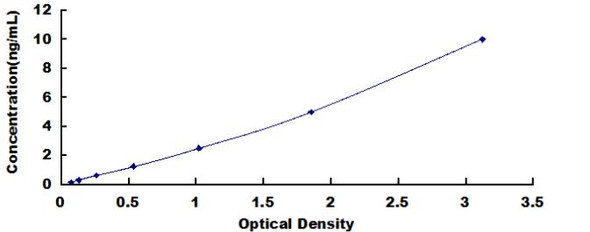Description
Human PDE1A (Phosphodiesterase 1A) ELISA Kit
The Human PDE1A (Phosphodiesterase 1A) ELISA Kit is a reliable tool for accurately measuring levels of PDE1A in human samples such as serum, plasma, and cell culture supernatants. With its high sensitivity and specificity, this kit provides consistent and reproducible results, making it suitable for a variety of research purposes.PDE1A is an important enzyme that plays a key role in regulating cellular signaling pathways by breaking down cyclic nucleotides. Its dysregulation has been implicated in various diseases, including cardiovascular disorders, neurological conditions, and cancer.
By studying PDE1A levels, researchers can gain valuable insights into disease mechanisms and potential therapeutic targets.Overall, the Human PDE1A ELISA Kit is an essential tool for researchers looking to investigate the role of PDE1A in various physiological and pathological processes, paving the way for new advancements in medical research and drug development.
| Product Name: | Human PDE1A (Phosphodiesterase 1A) ELISA Kit |
| Product Code: | HUFI07293 |
| Size: | 96 Assays |
| Alias: | 61 kDa Cam PDE ELISA Kit, Cam PDE 1A ELISA Kit, hCam 1 ELISA Kit, HCAM1 ELISA Kit, HSPDE1A ELISA Kit, PDE1A ELISA Kit |
| Detection method: | Sandwich ELISA, Double Antibody |
| Application: | This immunoassay kit allows for the in vitro quantitative determination of Human PDE1A (Phosphodiesterase 1A) concentrations in serum plasma and other biological fluids. |
| Sensitivity: | < 18.75pg/ml |
| Range: | 31.25-2000pg/ml |
| Storage: | 4°C for 6 months |
| Note: | For Research Use Only |
| Recovery: | Matrices listed below were spiked with certain level of Human PDE1A (Phosphodiesterase 1A) and the recovery rates were calculated by comparing the measured value to the expected amount of Human PDE1A (Phosphodiesterase 1A) in samples. Enquire for more information. |
| Linearity: | The linearity of the kit was assayed by testing samples spiked with appropriate concentration of Human PDE1A (Phosphodiesterase 1A) and their serial dilutions. The results were demonstrated by the percentage of calculated concentration to the expected. Enquire for more information. |
| CV(%): | Intra-Assay: CV<8% Inter-Assay: CV<10% |
| Component | Quantity | Storage |
| ELISA Microplate (Dismountable) | 8×12 strips | 4°C for 6 months |
| Lyophilized Standard | 2 | 4°C/-20°C |
| Sample/Standard Dilution Buffer | 20ml | 4°C |
| Biotin-labeled Antibody(Concentrated) | 120ul | 4°C (Protect from light) |
| Antibody Dilution Buffer | 10ml | 4°C |
| HRP-Streptavidin Conjugate(SABC) | 120ul | 4°C (Protect from light) |
| SABC Dilution Buffer | 10ml | 4°C |
| TMB Substrate | 10ml | 4°C (Protect from light) |
| Stop Solution | 10ml | 4°C |
| Wash Buffer(25X) | 30ml | 4°C |
| Plate Sealer | 5 | - |
Other materials and equipment required:
- Microplate reader with 450 nm wavelength filter
- Multichannel Pipette, Pipette, microcentrifuge tubes and disposable pipette tips
- Incubator
- Deionized or distilled water
- Absorbent paper
- Buffer resevoir
| UniProt Protein Function: | PDE1A: Cyclic nucleotide phosphodiesterase with a dual- specificity for the second messengers cAMP and cGMP, which are key regulators of many important physiological processes. Has a higher affinity for cGMP than for cAMP. Belongs to the cyclic nucleotide phosphodiesterase family. PDE1 subfamily. 9 isoforms of the human protein are produced by alternative splicing. |
| UniProt Protein Details: | Protein type:EC 3.1.4.17; Phosphodiesterase; Nucleotide Metabolism - purine Chromosomal Location of Human Ortholog: 2q32.1 Cellular Component: cell soma; nucleus; cytosol Molecular Function:calmodulin binding; 3',5'-cyclic-AMP phosphodiesterase activity; calmodulin-dependent cyclic-nucleotide phosphodiesterase activity; calcium- and calmodulin-regulated 3',5'-cyclic-GMP phosphodiesterase activity; metal ion binding; cGMP binding Biological Process: epidermal growth factor receptor signaling pathway; fibroblast growth factor receptor signaling pathway; regulation of smooth muscle cell proliferation; nerve growth factor receptor signaling pathway; phospholipase C activation; cAMP catabolic process; innate immune response; cGMP catabolic process; signal transduction; blood coagulation |
| NCBI Summary: | Cyclic nucleotide phosphodiesterases (PDEs) play a role in signal transduction by regulating intracellular cyclic nucleotide concentrations through hydrolysis of cAMP and/or cGMP to their respective nucleoside 5-prime monophosphates. Members of the PDE1 family, such as PDE1A, are Ca(2+)/calmodulin (see CALM1; MIM 114180)-dependent PDEs (CaM-PDEs) that are activated by calmodulin in the presence of Ca(2+) (Michibata et al., 2001 [PubMed 11342109]; Fidock et al., 2002 [PubMed 11747989]).[supplied by OMIM, Oct 2009] |
| UniProt Code: | P54750 |
| NCBI GenInfo Identifier: | 1705942 |
| NCBI Gene ID: | 5136 |
| NCBI Accession: | P54750.2 |
| UniProt Secondary Accession: | P54750,Q86VZ0, Q9C0K8, Q9C0K9, Q9C0L0, Q9C0L1, Q9C0L2 Q9C0L3, Q9C0L4, Q9UFX3, D3DPG5, |
| UniProt Related Accession: | P54750 |
| Molecular Weight: | 535 |
| NCBI Full Name: | Calcium/calmodulin-dependent 3',5'-cyclic nucleotide phosphodiesterase 1A |
| NCBI Synonym Full Names: | phosphodiesterase 1A, calmodulin-dependent |
| NCBI Official Symbol: | PDE1A |
| NCBI Official Synonym Symbols: | HCAM1; HCAM-1; HSPDE1A; CAM-PDE-1A |
| NCBI Protein Information: | calcium/calmodulin-dependent 3',5'-cyclic nucleotide phosphodiesterase 1A; cam-PDE 1A; 61 kDa Cam-PDE; calcium/calmodulin-stimulated cyclic nucleotide phosphodiesterase |
| UniProt Protein Name: | Calcium/calmodulin-dependent 3',5'-cyclic nucleotide phosphodiesterase 1A |
| UniProt Synonym Protein Names: | 61 kDa Cam-PDE; hCam-1 |
| Protein Family: | Calcium/calmodulin-dependent 3',5'-cyclic nucleotide phosphodiesterase |
| UniProt Gene Name: | PDE1A |
| UniProt Entry Name: | PDE1A_HUMAN |
*Note: Protocols are specific to each batch/lot. For the correct instructions please follow the protocol included in your kit.
Before adding to wells, equilibrate the SABC working solution and TMB substrate for at least 30 min at 37 °C. When diluting samples and reagents, they must be mixed completely and evenly. It is recommended to plot a standard curve for each test.
| Step | Protocol |
| 1. | Set standard, test sample and control (zero) wells on the pre-coated plate respectively, and then, record their positions. It is recommended to measure each standard and sample in duplicate. Wash plate 2 times before adding standard, sample and control (zero) wells! |
| 2. | Aliquot 0.1ml standard solutions into the standard wells. |
| 3. | Add 0.1 ml of Sample / Standard dilution buffer into the control (zero) well. |
| 4. | Add 0.1 ml of properly diluted sample ( Human serum, plasma, tissue homogenates and other biological fluids.) into test sample wells. |
| 5. | Seal the plate with a cover and incubate at 37 °C for 90 min. |
| 6. | Remove the cover and discard the plate content, clap the plate on the absorbent filter papers or other absorbent material. Do NOT let the wells completely dry at any time. Wash plate X2. |
| 7. | Add 0.1 ml of Biotin- detection antibody working solution into the above wells (standard, test sample & zero wells). Add the solution at the bottom of each well without touching the side wall. |
| 8. | Seal the plate with a cover and incubate at 37 °C for 60 min. |
| 9. | Remove the cover, and wash plate 3 times with Wash buffer. Let wash buffer rest in wells for 1 min between each wash. |
| 10. | Add 0.1 ml of SABC working solution into each well, cover the plate and incubate at 37 °C for 30 min. |
| 11. | Remove the cover and wash plate 5 times with Wash buffer, and each time let the wash buffer stay in the wells for 1-2 min. |
| 12. | Add 90 µL of TMB substrate into each well, cover the plate and incubate at 37 °C in dark within 10-20 min. (Note: This incubation time is for reference use only, the optimal time should be determined by end user.) And the shades of blue can be seen in the first 3-4 wells (with most concentrated standard solutions), the other wells show no obvious color. |
| 13. | Add 50 µL of Stop solution into each well and mix thoroughly. The color changes into yellow immediately. |
| 14. | Read the O.D. absorbance at 450 nm in a microplate reader immediately after adding the stop solution. |
When carrying out an ELISA assay it is important to prepare your samples in order to achieve the best possible results. Below we have a list of procedures for the preparation of samples for different sample types.
| Sample Type | Protocol |
| Serum | If using serum separator tubes, allow samples to clot for 30 minutes at room temperature. Centrifuge for 10 minutes at 1,000x g. Collect the serum fraction and assay promptly or aliquot and store the samples at -80°C. Avoid multiple freeze-thaw cycles. If serum separator tubes are not being used, allow samples to clot overnight at 2-8°C. Centrifuge for 10 minutes at 1,000x g. Remove serum and assay promptly or aliquot and store the samples at -80°C. Avoid multiple freeze-thaw cycles. |
| Plasma | Collect plasma using EDTA or heparin as an anticoagulant. Centrifuge samples at 4°C for 15 mins at 1000 × g within 30 mins of collection. Collect the plasma fraction and assay promptly or aliquot and store the samples at -80°C. Avoid multiple freeze-thaw cycles. Note: Over haemolysed samples are not suitable for use with this kit. |
| Urine & Cerebrospinal Fluid | Collect the urine (mid-stream) in a sterile container, centrifuge for 20 mins at 2000-3000 rpm. Remove supernatant and assay immediately. If any precipitation is detected, repeat the centrifugation step. A similar protocol can be used for cerebrospinal fluid. |
| Cell culture supernatant | Collect the cell culture media by pipette, followed by centrifugation at 4°C for 20 mins at 1500 rpm. Collect the clear supernatant and assay immediately. |
| Cell lysates | Solubilize cells in lysis buffer and allow to sit on ice for 30 minutes. Centrifuge tubes at 14,000 x g for 5 minutes to remove insoluble material. Aliquot the supernatant into a new tube and discard the remaining whole cell extract. Quantify total protein concentration using a total protein assay. Assay immediately or aliquot and store at ≤ -20 °C. |
| Tissue homogenates | The preparation of tissue homogenates will vary depending upon tissue type. Rinse tissue with 1X PBS to remove excess blood & homogenize in 20ml of 1X PBS (including protease inhibitors) and store overnight at ≤ -20°C. Two freeze-thaw cycles are required to break the cell membranes. To further disrupt the cell membranes you can sonicate the samples. Centrifuge homogenates for 5 mins at 5000xg. Remove the supernatant and assay immediately or aliquot and store at -20°C or -80°C. |
| Tissue lysates | Rinse tissue with PBS, cut into 1-2 mm pieces, and homogenize with a tissue homogenizer in PBS. Add an equal volume of RIPA buffer containing protease inhibitors and lyse tissues at room temperature for 30 minutes with gentle agitation. Centrifuge to remove debris. Quantify total protein concentration using a total protein assay. Assay immediately or aliquot and store at ≤ -20 °C. |
| Breast Milk | Collect milk samples and centrifuge at 10,000 x g for 60 min at 4°C. Aliquot the supernatant and assay. For long term use, store samples at -80°C. Minimize freeze/thaw cycles. |







